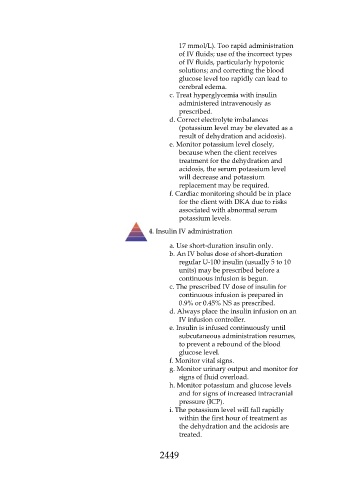Page 2449 - Saunders Comprehensive Review For NCLEX-RN
P. 2449
17 mmol/L). Too rapid administration
of IV fluids; use of the incorrect types
of IV fluids, particularly hypotonic
solutions; and correcting the blood
glucose level too rapidly can lead to
cerebral edema.
c. Treat hyperglycemia with insulin
administered intravenously as
prescribed.
d. Correct electrolyte imbalances
(potassium level may be elevated as a
result of dehydration and acidosis).
e. Monitor potassium level closely,
because when the client receives
treatment for the dehydration and
acidosis, the serum potassium level
will decrease and potassium
replacement may be required.
f. Cardiac monitoring should be in place
for the client with DKA due to risks
associated with abnormal serum
potassium levels.
4. Insulin IV administration
a. Use short-duration insulin only.
b. An IV bolus dose of short-duration
regular U-100 insulin (usually 5 to 10
units) may be prescribed before a
continuous infusion is begun.
c. The prescribed IV dose of insulin for
continuous infusion is prepared in
0.9% or 0.45% NS as prescribed.
d. Always place the insulin infusion on an
IV infusion controller.
e. Insulin is infused continuously until
subcutaneous administration resumes,
to prevent a rebound of the blood
glucose level.
f. Monitor vital signs.
g. Monitor urinary output and monitor for
signs of fluid overload.
h. Monitor potassium and glucose levels
and for signs of increased intracranial
pressure (ICP).
i. The potassium level will fall rapidly
within the first hour of treatment as
the dehydration and the acidosis are
treated.
2449

